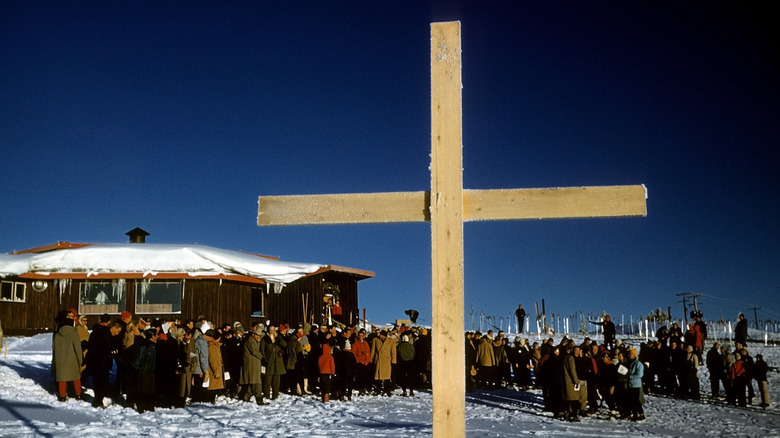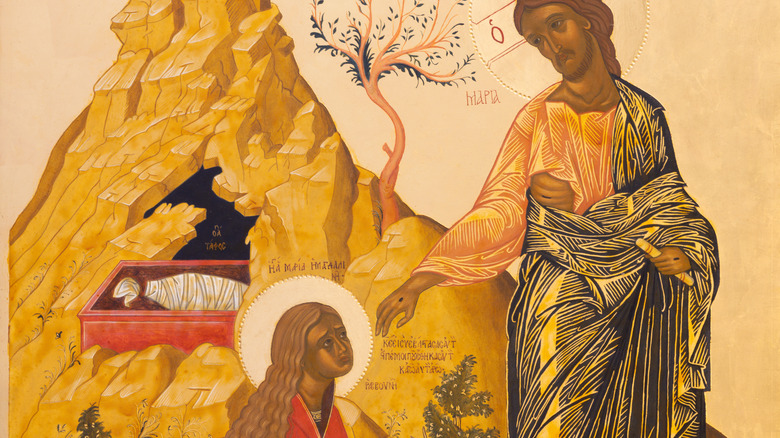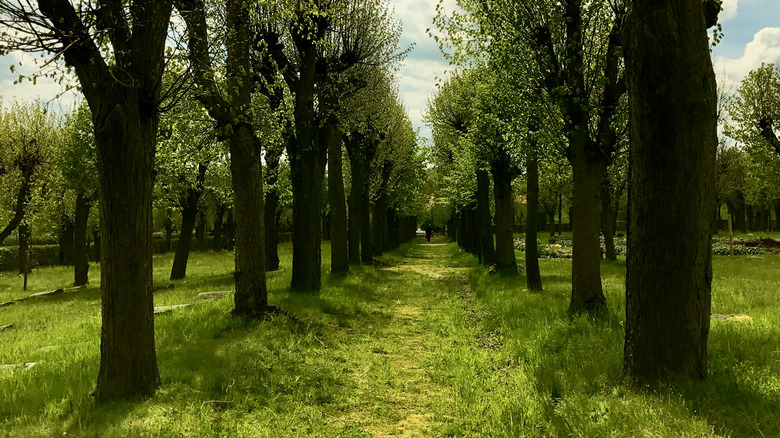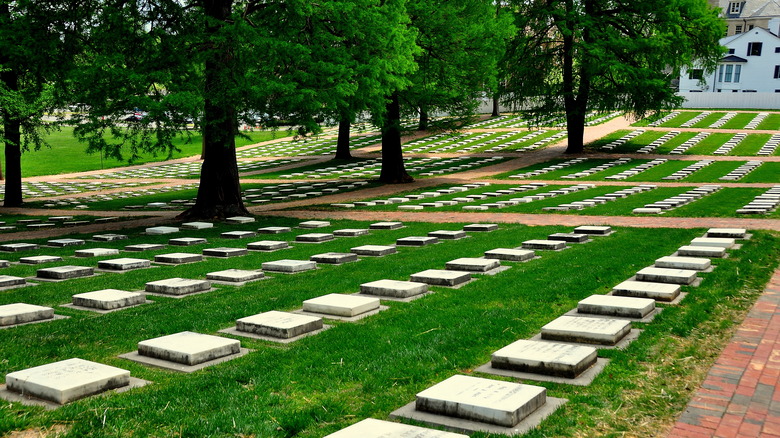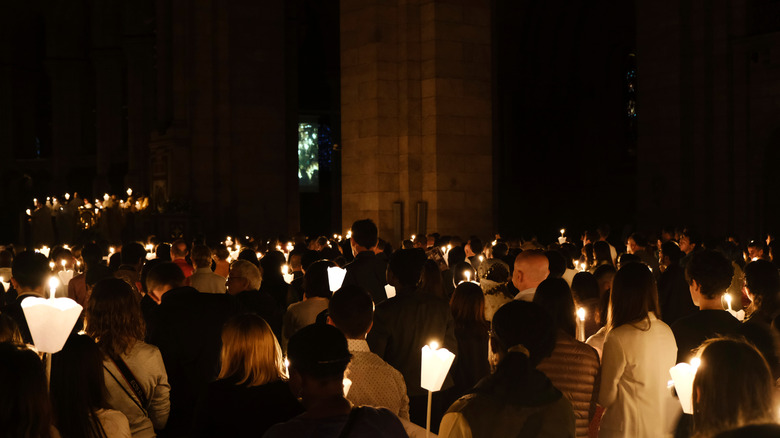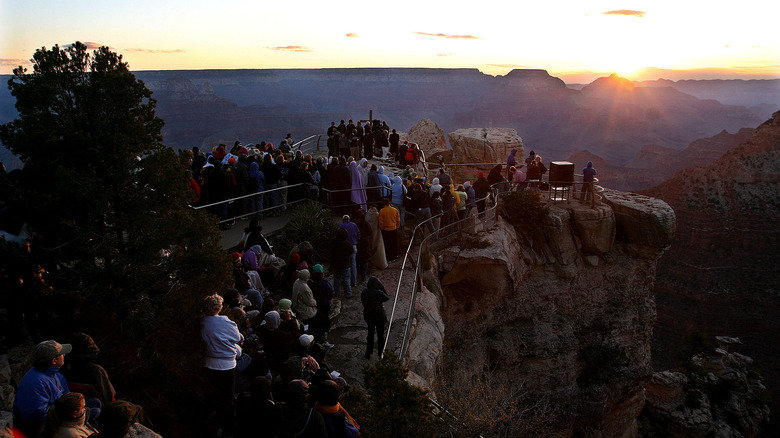The Origin Of The Easter Sunrise Service
The sleepiest, prettiest Christian church service of the year often comes early on Easter morning, when churches host a "sunrise service" outside, usually in a place on high ground so parishioners can easily see the sunrise over the horizon. But how did these church services begin?
Easter is a celebration of the Christian belief that Jesus of Nazareth rose from the dead three days after his death by crucifixion. But it has long been believed that the celebration of Easter may have pagan roots — a popular theory holds that even the name "Easter" comes from "Eostre," the Anglo-Saxon spring goddess. In fact, Britannica says, this is likely untrue, and there is now consensus that the name "Easter" comes from the old German "eostarum," meaning "dawn."
This in turn came from the Latin "hebdomada alba," which could be translated as "dawn week," though it actually meant "white week," in reference to the white clothes of the people baptized during the Easter Vigil, according to Crosswalk. The German translation was in error, but it goes to show that sunrises have long had an easy association with Easter celebrations.
The Biblical rationale behind Easter sunrise services
In all four Gospel accounts of the resurrection of Jesus, one of Jesus's followers, Mary Magdalene, is the first to see that Jesus's tomb is empty (via Haverford). Though the accounts sometimes vary in their details, they all take place in the early morning on Sunday. In the Gospel of John, this was when "it was still dark" out; in Luke and Matthew, at dawn; in Mark, shortly after the sun had risen.
The accounts vary slightly, but in John, Mary first sees angels in the place where Jesus's body had been kept (via Bible Gateway). She then turns around and sees Jesus, though she doesn't know it's him at first; she thinks it's a gardener, and she asks him if he knows where people have moved Jesus's body. Jesus responds with her name, and she cries "Rabboni!", meaning teacher. Jesus then tells her not to touch him, because he hasn't ascended into heaven yet. Mary instead runs to tell the other disciples what she saw.
The practice was started by an early Protestant denomination
Mary's joyful reunion with Jesus might be considered the first Easter celebration, making a dawn religious service a natural thing. But the process was only formalized relatively recently, by the Morovians, one of the earliest Protestant groups. According to the Morovians (via Salem Congregation), the first sunrise service was held in Herrnhut, Germany in 1732. Then, before dawn, a collection of unmarried men met in a graveyard — called "God's Acre" in the Morovian tradition — and worshiped Jesus as the sun rose. According to Woman's Day, the following year everyone in the community joined these men in this form of worship, and it became an annual tradition.
As the Morovian community grew and spread throughout the world, these Protestants took the tradition of the sunrise service with them. Soon it spread to other denominations as well. Today it is largely practiced in North America among Protestant denominations, according to Britannica.
The longest-running sunrise service in America is in North Carolina
The first of these sunrise services was held in the Morovian community of Winston-Salem, North Carolina in 1772, according to Time. The ceremony on April 17, 2022 marks its 250th Easter sunrise service.
The first sunrise service in Winston-Salem was held with largely the same traditions and customs as the German service 40 years earlier, according to Salem Congregation, the church that hosts the service. The congregation begins at 2 a.m., when the church band — now some 500 people — plays hymns throughout the town, both to remind listeners about the resurrection and to wake people up for the morning service. The first song played is "Sleepers, Wake!", with its melody by Johann Sebastian Bach.
After parishioners gather in Salem Square by 6 a.m., the service begins, according to Morovian Sunrise, which streams the church service. After the initial readings, the congregation then walks in "prayerful silence" to Winston-Salem's own "God's Acre."
Easter sunrise church services may be inspired by the Easter Vigil
In many church denominations, the sunrise service is preceded by an Easter Vigil the night before on Holy Saturday, which may also include themes of light and resurrection, according to Britannica. Holy Saturday marks Jesus's final day of death, a time in which he is traditionally believed to have spent in hell.
Beginning in the early Catholic Church, the end of Lent was historically a time of baptism — hence, the rationale for calling Holy Week "White Week." Those baptisms were combined with rituals of candle-carving and lighting fires as part of a nighttime service (per Catholic Culture). In the Catholic Church, this nighttime vigil lasts anywhere from 2.5 to 3 hours, according to CBS News.
In some churches, the service lasts past midnight, making this the first mass of Easter Sunday. In fact, medievalists say, these vigils are more moderate than those of the early church — when vigils would last until dawn (per Modern Medievalism). That's a sunrise service for real traditionalists.
Some sunrise church services are in really cool locations
Though the Morovians might traditionally hold their sunrise service in a graveyard, there are cheerier sunrise services available to worshipers as well. The Los Angeles Philharmonic performs a regular Easter Sunday sunrise service at the Hollywood Bowl — and it has been doing so since 1921 (via LA Philharmonic). The Lincoln Memorial hosts one too, in what has become a tradition spanning over four decades, according to the Christian Post.
Since sunrise services are traditionally held in the great outdoors, it's no surprise that many of the most notable such services take place in gorgeous parks. Most years, you can attend one at the summit of Stone Mountain in Georgia (via Mental Floss), at the Grand Canyon (via Grand Canyon Community Church), or on the boardwalk in Ocean City, Maryland (via Ocean City). It's a beautiful way to keep your Christian faith while traveling, if you so choose.
